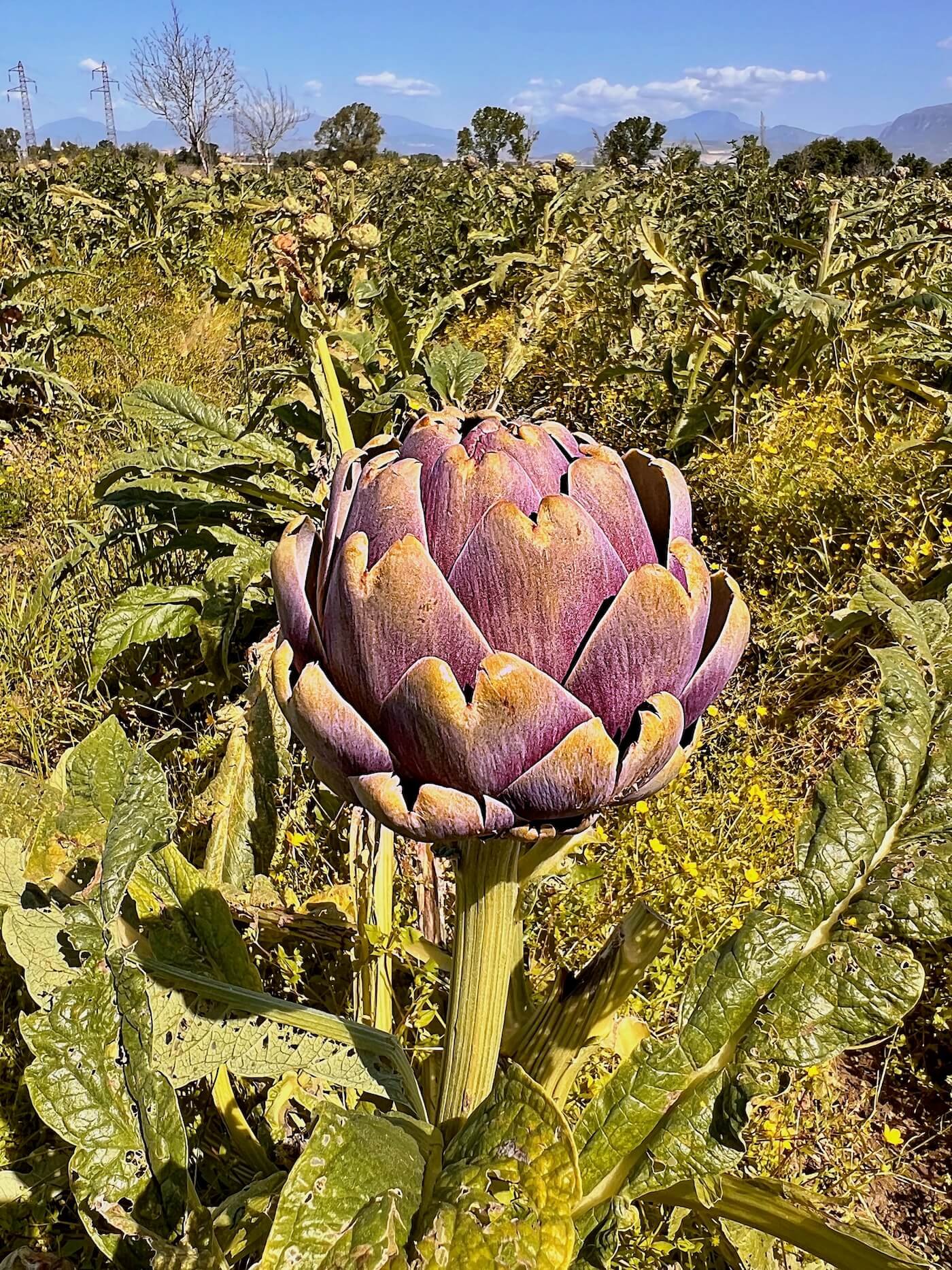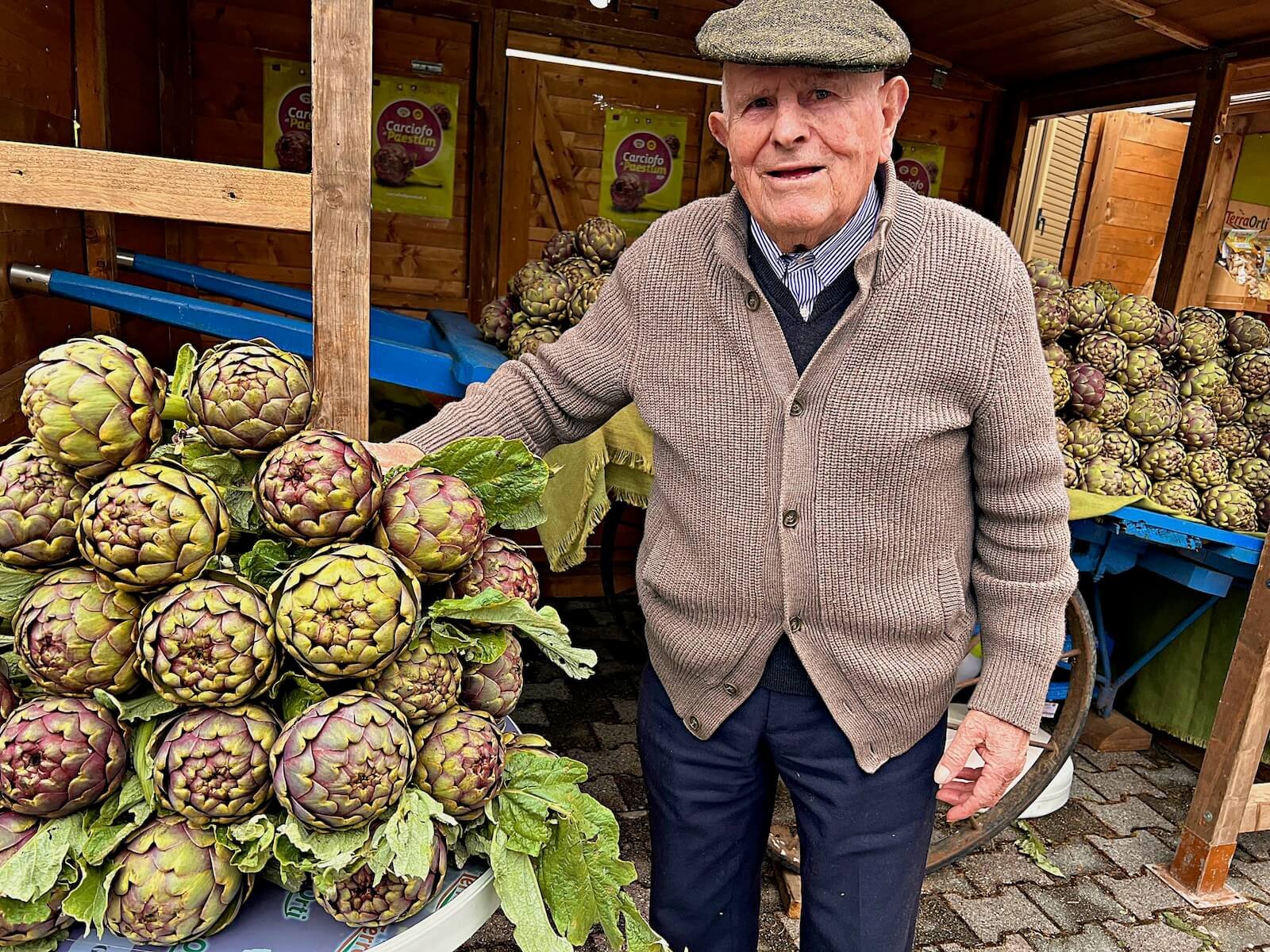Advertisement
Consuming Passions: Artichokes
16 May 2024 · Consuming passions

Kerstin Rodgers, freshly back from Italy’s famous artichoke festival in Paestum, near Naples, celebrates her passion for growing, cooking and eating this delicious, but often overlooked, vegetable.
If there is any doubt that I have a Consuming Passion for artichokes, consider the fact I have just spent three days at an artichoke festival in Italy, ate and drank nothing that didn’t contain artichokes for the entire period, and I liked it.
My passion is for globe artichokes, not Jerusalem artichokes (or ‘fartichokes’ as I call them). I first had a globe artichoke when I was about 11 years old. We were on one of our family road trips to the south west of France, where my parents had a 12th-century very rustic house near a village called Condom (tee hee).
In those days you’d get a ridiculously cheap set menu in local restaurants, three courses with a quarter-litre of wine, even for kids. One time the starter was a whole steamed artichoke, which is essentially a large round scaly thistle. I’d never seen one before and had no idea how to tackle it. My parents showed me: you pluck off the outer leaves, dipping the leaf into the accompanying vinaigrette, using your bottom teeth to scrape off the rim of flesh.

Artichoke Vinaigrette from Professional Garde Manger by Jaclyn Pestka, Wayne Gisslen and Lou Sackett
Once you’ve done this, piling up a large heap of discarded leaves, you get to the ‘choke’ – a hairy inedible flower, which is aptly named. This must be sliced off, then you are left with an artichoke bottom, which tastes the same as the morcels on the leaves but now you’ve earnt several whole mouthfuls. The taste? Subtle, vegetal, green, perfumed. Hard to describe but similar to asparagus. It is part of the edible thistle family, and probably descended from the wild cardoon, which is equally delicious but even more difficult to prepare.
The artichoke festival takes place annually in Paestum, an hour south of Naples. This is a traditional growing area, similar to Lazio near Rome, for artichokes. In recent years, growing this crop has declined. Farmers turned to alfalfa, to feed the buffalo herds whose milk makes mozzarella, another speciality of the region.
For the last 15 years, the festival promotes the local artichoke crop and the dishes you can make with it. For three days I ate all kinds of artichokes: two types of stuffed artichokes, BBQ artichokes, artichoke fritters, artichoke on pizza, artichoke pasta, artichoke risotto, artichoke cream bruschetta, artichoke gelato (surprisingly good), artichoke beer and artichoke spritz.

BBQ artichokes

Artichoke fritters

Artichoke gelato
In truth, preparing artichokes in large numbers is a pain – believe me, I know from first-hand experience. A day prepping artichokes for a supper club for 35 guests without gloves led to sore, blackened, stained and cut hands.
In a long shed behind the artichoke festival, a collection of women with lovely names like Apollonia wore black rubber gloves to prep all day, chucking the hearts and bottoms into large buckets of water with lemon and flour to prevent them blackening. Hard work, only leavened by village gossip and regular servings of Aperol spritz. I went behind to photograph them and was offered a drink.

They’d been plucking chokes since 8am from farmer and festival organiser Gianfranco Di Iacono’s farm. Why is this area famous for artichokes? ‘It’s the clay soil and the fact we have 270 days of sunshine a year,’ they replied.
Artichokes are very good for your health, containing inulin, a vegetable fibre. We should all be eating more inulin, to improve our digestion and gut microbiome. One artichoke will provide a quarter of your daily fibre. If you take a sip of water after eating artichoke, it will taste fresh and fragrant as if from a mountain spring.
You will find huge numbers of recipes using globe artichokes on ckbk. The two most classic artichoke dishes, carciofi alla giudia and carciofi alla romana, come from Rome. The variety of artichoke traditionally used for these dishes is Romanesco, purple and non-spiny, which has been cultivated since the 1400s.
The nickname given to artichokes in the Campagna district is marmorella. But in the Lazio dialect they are called mammole. The name means mother in Italian – mamma. These are the first ones picked, from January to February; they have the largest globe, with the motherlode stem in the middle of the plant. The smaller artichokes surrounding the mamma are literally the daughters, figlie, and they are picked from March to May and used for preserving, in tins, jars or sot’olio. If the artichokes are left to flower, they become stunning architectural purple flowers in June or July.

When in Rome, I ate at Nonna Betta restaurant in the Jewish quarter. I was impressed by their pasticcio di carciofi, a lasagna dish made with artichokes: soft, yielding and delicate. Here’s a recipe for mini lasagnes with artichokes and tomato sauce and an unusual recipe from chef Paul Gayler for a salad in which artichokes and avocado are interleaved with lasagne sheets.
Pasta can be combined with preserved or fresh baby artichoke hearts as in this recipe for fresh pappardelle, or linguine carbonara with peas and artichokes, or mixed with dairy such as in Sue Quinn’s recipe for fusilli with artichoke cream or this delicious-sounding Sardinian recipe for lemon taglierini with sea urchin and artichoke cream. Celebrated vegetarian restaurant The Gate includes a recipe for their artichoke pesto in their cookbook.

Lemon Taglierini with Sea Urchin and Artichoke Cream from A Sardinian Cookbook by Giovanni Pilu and Roberta Muir
Risotto options include Shaun Hill’s saffron and artichoke risotto, Tessa Kiros’ Venetian risotto di verdure, or Grande Dame of Italian cookery Marcella Hazan’s risotto coi Carciofi.
At the festival I tried an interesting recipe for stuffed artichokes called, in local Neapolitan dialect, mbuttunati carciofi. Two heads for five euros, these were stuffed with egg, cheese and breadcrumbs, and braised in a tomato sauce. Here are some other ideas for stuffing: Josceline Dimbleby’s intriguing Artichokes with Yellow Mystery Sauce, a Sicilian-style anchovy, garlic, and pine nut stuffed artichoke, Keith Floyd’s red mullet stuffed artichokes, or fava bean stuffed artichokes from Jeremiah Tower. I really need to up my stuffed artichoke game!
In Italy and the Italian diaspora in the United States, they will use finely shaved raw artichokes for a salad. This very cheffy recipe by French-Australian chef Damien Pignolet uses a combination of cooked and raw artichoke; quick-cooking the leaves and stem but leaving the heart raw.
Out of season, you can always use tinned or jarred artichokes, in brine or oil — see this collection of recipes for jarred artichoke hearts. There are also many ways to combine artichokes with other ingredients to make a dip. Try Signe Johansen’s artichoke, almond and parmesan dip or combine it with spinach in this dip recipe by Drew Maresco, one of his innovative and surprising uses for a slow-cooker.
I left this festival determined to visit other artichoke festivals, such as these in Rome and in California. I’m not cured of my addiction – in fact, it’s only whetted my appetite for artichokes even more.

Kerstin’s selection of artichoke recipes
More Consuming Passions
Anglo-Australian food writer Jill Dupleix has a cupboard full, and shares ideas on how to make the most of them
Kerstin Rodgers with a guide to one of her other favourite passions, the deep purple aubergine / eggplant of emoji fame
Kumud Gandhi, founder of The Cooking Academy and author of The Garlic Story, considers garlic one of her ingredient holy trinity
Sign up for ckbk's weekly email newsletter
Advertisement





